[press release]
It’s A Bug’s Life!
New Special Stamps from Royal Mail Celebrate Pollinating Insects of The UK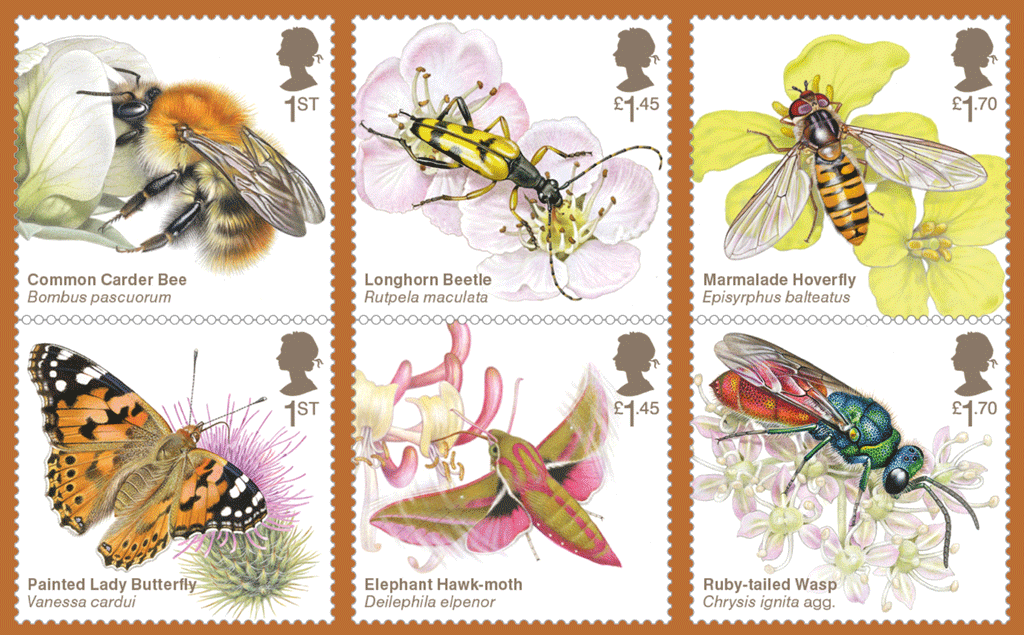
- Royal Mail today launches a set of Special Stamps that celebrate the diversity, intrigue and importance of pollinating insects in the UK
- Entitled ‘Brilliant Bugs’, the stamps celebrate pollinators and explore bees and butterflies – and other often overlooked important pollinators including moths, beetles, hoverflies and wasps
- Six important insect pollinators are featured: Common Carder Bee; Painted Lady Butterfly; Longhorn Beetle; Elephant Hawk-moth; Marmalade Hoverfly; and Ruby-tailed Wasp
- Pollinators are responsible for pollination of vast quantities of food crops for humans and farm animals and the pollination of wild plants including flowers and some trees
- There are thought to be more than five million species of these ‘brilliant bugs’ worldwide, although, there is growing evidence the numbers of insects, including some pollinators, are declining
- Royal Mail worked with ecologist and entomologist, Professor Helen Roy MBE, from the UK Centre for Ecology & Hydrology, on the stamp set
- The stamps were illustrated by Oxfordforshire-based, wildlife artist, Richard Lewington
- The full set of six stamps, available in a Presentation Pack, retails at £8.70. The stamps and a range of collectible products are available now from www.royalmail.com/brilliantbugs
Royal Mail has launched a set of six stamps that celebrate the diversity, intrigue and importance of insects which pollinate plants in the UK.
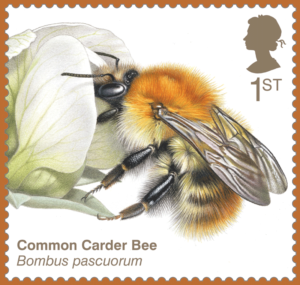 The stamps explore insects — including bees and butterflies — and other often overlooked important pollinators, including moths, beetles, hoverflies and wasps.
The stamps explore insects — including bees and butterflies — and other often overlooked important pollinators, including moths, beetles, hoverflies and wasps.
Featured are six important insect pollinators feeding on flowers they typically visit: Common Carder Bee; Painted Lady Butterfly; Longhorn Beetle; Elephant Hawk-moth; Marmalade Hoverfly; and Ruby-tailed Wasp.
Pollinators are responsible for pollination of vast quantities of food crops for humans and farm animals and the pollination of wild plants including flowers and some trees. Of all plants worldwide, more than 85% are pollinated by insects and other animals.
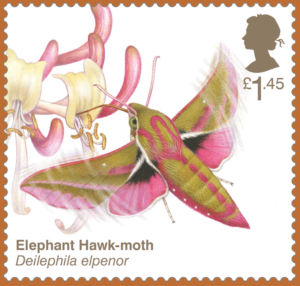 There are thought to be more than five million species of these ‘brilliant bugs’ worldwide.
There are thought to be more than five million species of these ‘brilliant bugs’ worldwide.
Bees are the main pollinators in most ecosystems; there are over 20,000 species worldwide and more than 250 are found in the UK. Flies are considered the second most important group of pollinators; there are a staggering 120,000 species of fly worldwide. In addition to bees and flies, some species of butterfly, moth, wasp, beetle as well as thrip, are also considered important visitors to flowers.
There have been many reports that pollinating insects are undergoing significant declines around the world. Many reasons are given for these declines – from climate change to how we manage landscapes. A recent study in Britain showed that, over the last three 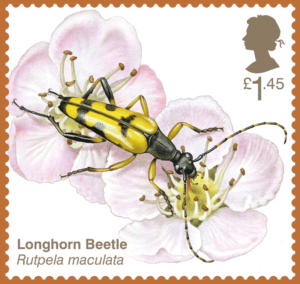 decades, one third of bee and hoverfly species have declined.
decades, one third of bee and hoverfly species have declined.
To combat the declines, farmers around the world are putting flower-rich habitats back on the land they manage. Consequently, they are seeing an increase in the number of pollinating insects.
We can increase the numbers of flowers in urban landscapes by growing plants attractive to pollinating insects. There are many to choose from, including cowslips, bugle and heathers.
Vetches, dandelions, clovers and many of the flowers that appear in lawns also provide a rich source of nectar for pollinating insects – so patches of unmown lawn can be beneficial.
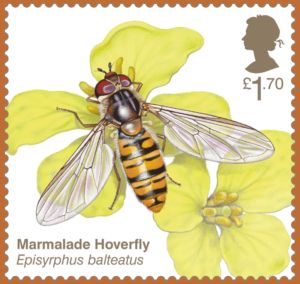 Royal Mail worked with ecologist and entomologist Professor Helen Roy MBE, from the UK Centre for Ecology & Hydrology, on the stamp set.
Royal Mail worked with ecologist and entomologist Professor Helen Roy MBE, from the UK Centre for Ecology & Hydrology, on the stamp set.
Professor Roy, said: “Insects are captivating, and I was delighted to be invited to join Royal Mail in celebrating insect pollinators.”
The stamps were illustrated by Oxfordshire-based, renowned wildlife artist, Richard Lewington.
Richard said: “At a time when the plight of insects as pollinators has much been in the news, I was delighted to be commissioned by Royal Mail, to highlight the importance and incredible diversity of 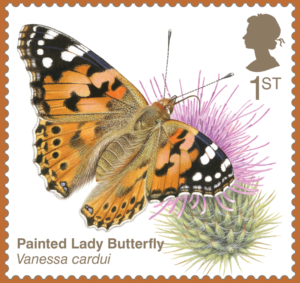 ‘Brilliant Bugs’.
‘Brilliant Bugs’.
Philip Parker, Royal Mail said: “Our exquisite new stamps depict colourful insects feeding on some of the flowers they frequent. We mark the vital role they play in pollinating wild flowers and crops: from bees and butterflies to the often-underappreciated work of hoverflies, moths, wasps and beetles.”
Stamp by stamp:
Common Carder Bee (Bombus pascuorum)
Depicted on large blue pea flower. One of the 24 species of bumblebee that live in the UK, this ginger-coloured bee can be found in many different habitats including gardens.
Painted Lady Butterfly (Vanessa cardui)
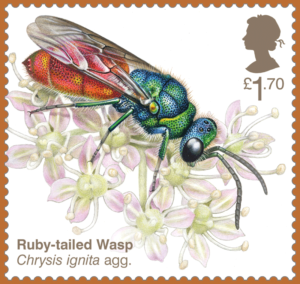 Depicted on thistle. This migratory butterfly travels vast distances from the Middle East and Central Asia before arriving in the UK during the summer months.
Depicted on thistle. This migratory butterfly travels vast distances from the Middle East and Central Asia before arriving in the UK during the summer months.
Longhorn Beetle (Rutpela maculate)
Depicted on flowering hawthorn. This species lives for several years in its larval stage feeding on decaying wood, finally emerging as the striking, wasp-mimicking adult illustrated on the stamp to live for between two and four weeks.
Elephant Hawk-moth (Deilephila elpenor)
Depicted on honeysuckle. More than 2500 species of moth have been recorded in the UK. The elephant hawk-moth’s pink and green wings span 45-60mm.
Marmalade Hoverfly (Episyrphus balteatus)
Depicted on oilseed rape. In the UK there are more than 280 species of hoverfly. Favouring flat-topped flowers to land and fed on, it is commonly seen in gardens and is an important pollinator of crops.
Ruby-tailed Wasp (Chrysis ignita agg.)
Depicted on angelica. While the adult ruby-tailed wasp feeds on the nectar of flowers, the young larvae eat the eggs and larvae of other insect species.
The full set of six stamps, available in a Presentation Pack, retails at £8.70.
The stamps and a range of collectible products are available at: www.royalmail.com/brilliantbugs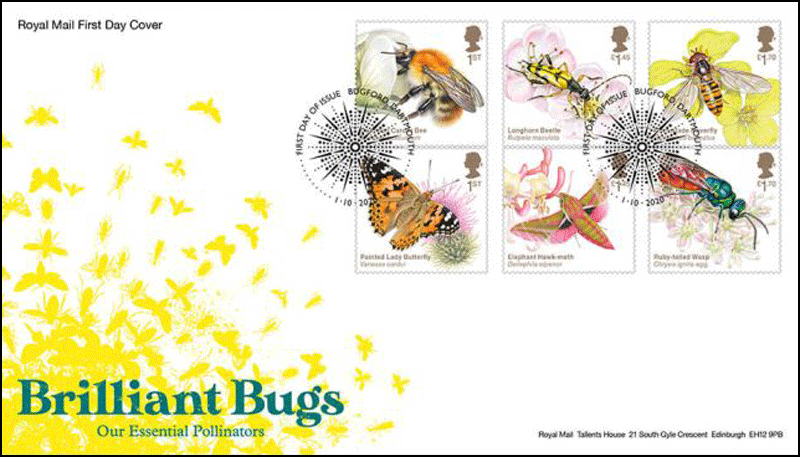

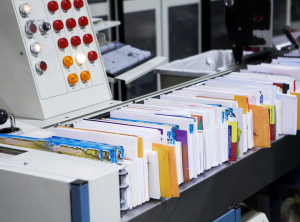 The proposed prices, approved by the Postal Service Board of Governors, would raise Mailing Services product prices approximately 1.8 percent for First-Class Mail and 1.5 percent for other categories. Although Mailing Services price increases are based on the consumer price index, competitive International Shipping Services prices are primarily adjusted according to market conditions. The governors believe these new rates will keep the Postal Service competitive while providing the agency with needed revenue.
The proposed prices, approved by the Postal Service Board of Governors, would raise Mailing Services product prices approximately 1.8 percent for First-Class Mail and 1.5 percent for other categories. Although Mailing Services price increases are based on the consumer price index, competitive International Shipping Services prices are primarily adjusted according to market conditions. The governors believe these new rates will keep the Postal Service competitive while providing the agency with needed revenue.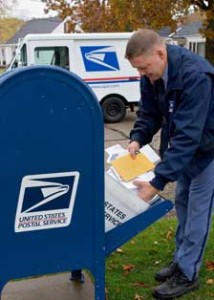 Postal Service does not add surcharges for fuel, residential delivery or regular Saturday delivery.
Postal Service does not add surcharges for fuel, residential delivery or regular Saturday delivery.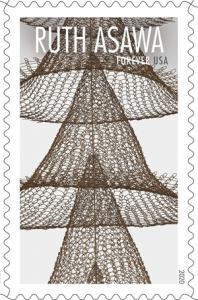 5505 (55¢) Wire Sculptures by Ruth Asawa – Untitled Sculpture from 1959
5505 (55¢) Wire Sculptures by Ruth Asawa – Untitled Sculpture from 1959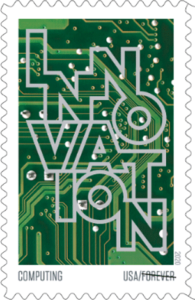 5514 (55¢) Innovation – Computing
5514 (55¢) Innovation – Computing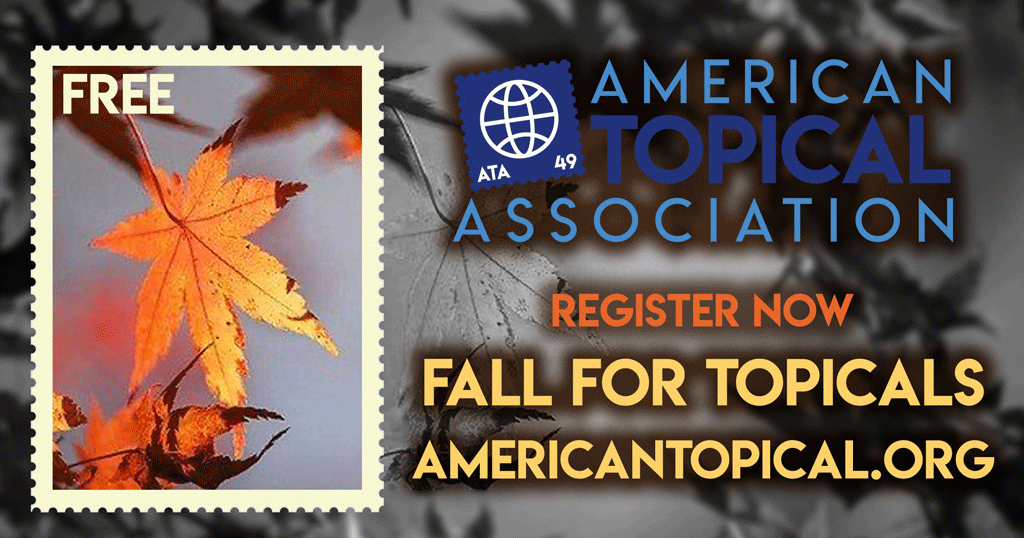 The subjects are:
The subjects are: Balfour Mount, M. Vera Peters, James Till and Ernest McCulloch. Their contributions to the fields of pediatric pathology, HIV/AIDS, palliative care, oncology and stem cell science changed the practice of medicine in Canada and around the world.
Balfour Mount, M. Vera Peters, James Till and Ernest McCulloch. Their contributions to the fields of pediatric pathology, HIV/AIDS, palliative care, oncology and stem cell science changed the practice of medicine in Canada and around the world.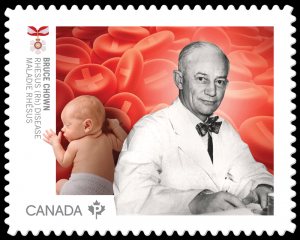 a manageable condition with a near-normal life expectancy and has markedly reduced HIV transmission. Dr. Mount, O.C., O.Q. (b. 1939), considered the father of palliative care in North America, founded the world’s first comprehensive palliative care service based in a teaching hospital. Dr. Peters, O.C.(1911-93) revolutionized treatment for Hodgkin lymphoma and breast cancer in an era when the work of female physician scientists was not often acknowledged. Dr. Till, O.C., O. Ont. (b. 1931) and Dr.
a manageable condition with a near-normal life expectancy and has markedly reduced HIV transmission. Dr. Mount, O.C., O.Q. (b. 1939), considered the father of palliative care in North America, founded the world’s first comprehensive palliative care service based in a teaching hospital. Dr. Peters, O.C.(1911-93) revolutionized treatment for Hodgkin lymphoma and breast cancer in an era when the work of female physician scientists was not often acknowledged. Dr. Till, O.C., O. Ont. (b. 1931) and Dr.  McCulloch, O.C., O. Ont. (1926-2011) transformed the world’s understanding of tissue renewal by establishing the foundations of stem cell science.
McCulloch, O.C., O. Ont. (1926-2011) transformed the world’s understanding of tissue renewal by establishing the foundations of stem cell science. pandemic.
pandemic.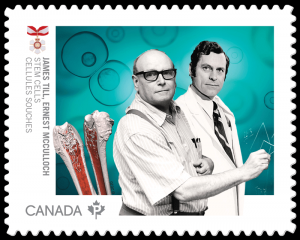 TORONTO, le 14 sept. 2020 /CNW/ – Aujourd’hui, Postes Canada a émis un jeu de cinq timbres commémoratifs célébrant six pionniers de la médecine : la Dre M. Vera Peters, les Drs Bruce Chown, Julio Montaner, Balfour Mount et Ernest McCulloch, et le chercheur James Till. Leurs contributions dans les domaines de l’oncologie, de la médecine pédiatrique, de la recherche sur le VIH/sida, des soins palliatifs et de l’étude des cellules souches ont transformé la pratique de la médecine au Canada et partout dans le monde.
TORONTO, le 14 sept. 2020 /CNW/ – Aujourd’hui, Postes Canada a émis un jeu de cinq timbres commémoratifs célébrant six pionniers de la médecine : la Dre M. Vera Peters, les Drs Bruce Chown, Julio Montaner, Balfour Mount et Ernest McCulloch, et le chercheur James Till. Leurs contributions dans les domaines de l’oncologie, de la médecine pédiatrique, de la recherche sur le VIH/sida, des soins palliatifs et de l’étude des cellules souches ont transformé la pratique de la médecine au Canada et partout dans le monde. Le Dr Chown, O.C., M.C. (1893-1986), a été l’un des premiers dans le monde à éliminer la maladie rhésus (Rh) qui entraînait autrefois la mort de nombreux nouveau-nés. Grâce au Dr Montaner, O.C., O.B.C. (né en 1956), le VIH/SIDA est devenu une maladie chronique gérable, son taux a grandement diminué et les personnes qui en sont atteintes ont maintenant une longévité comparable au reste de la population. Considéré comme le pionnier des soins palliatifs en Amérique du Nord, le Dr Mount, O.C., O.Q. (né en 1939), a
Le Dr Chown, O.C., M.C. (1893-1986), a été l’un des premiers dans le monde à éliminer la maladie rhésus (Rh) qui entraînait autrefois la mort de nombreux nouveau-nés. Grâce au Dr Montaner, O.C., O.B.C. (né en 1956), le VIH/SIDA est devenu une maladie chronique gérable, son taux a grandement diminué et les personnes qui en sont atteintes ont maintenant une longévité comparable au reste de la population. Considéré comme le pionnier des soins palliatifs en Amérique du Nord, le Dr Mount, O.C., O.Q. (né en 1939), a 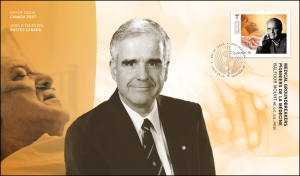 fondé le premier service de soins palliatifs complet au monde dans un hôpital d’enseignement. La Dre Peters, O.C. (1911-1993), a révolutionné le traitement du lymphome de Hodgkin et du cancer du sein à une époque où les femmes chercheures en médecine n’étaient guère reconnues. James Till, O.C., O. Ont. (né en 1931), et le Dr Ernest McCulloch, O.C., O. Ont. (1926-2011), ont transformé la notion de renouvellement des
fondé le premier service de soins palliatifs complet au monde dans un hôpital d’enseignement. La Dre Peters, O.C. (1911-1993), a révolutionné le traitement du lymphome de Hodgkin et du cancer du sein à une époque où les femmes chercheures en médecine n’étaient guère reconnues. James Till, O.C., O. Ont. (né en 1931), et le Dr Ernest McCulloch, O.C., O. Ont. (1926-2011), ont transformé la notion de renouvellement des  tissus en prouvant l’existence des cellules souches.
tissus en prouvant l’existence des cellules souches.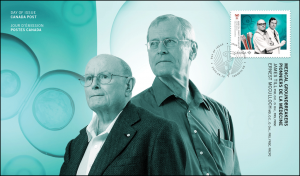
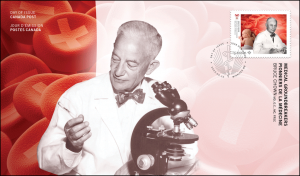 contributions remarquables.
contributions remarquables.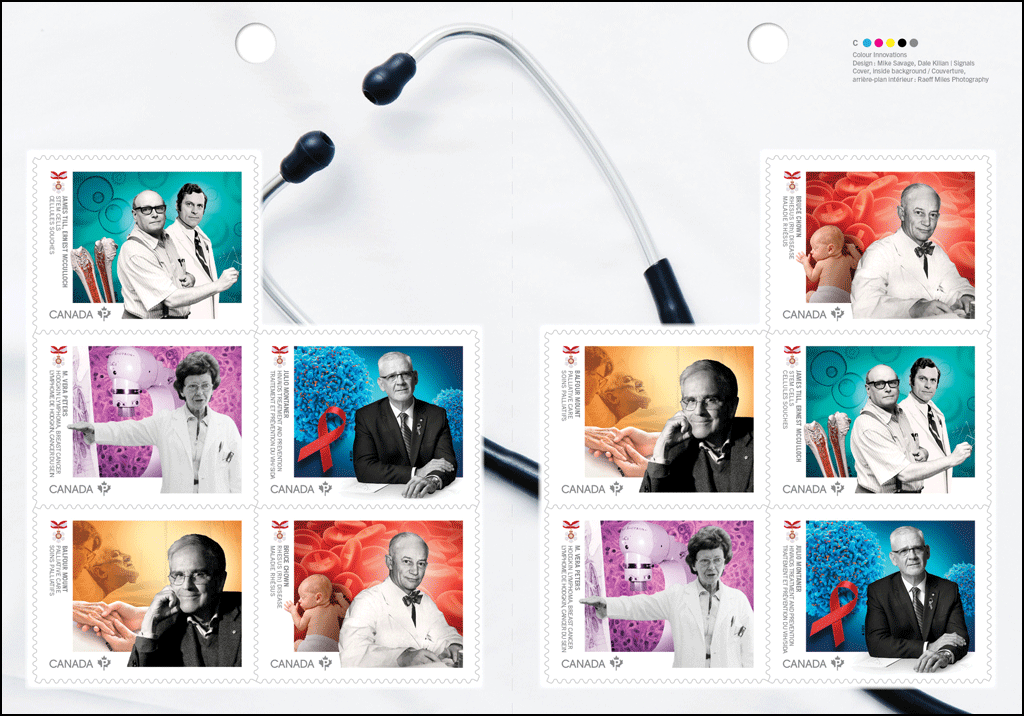

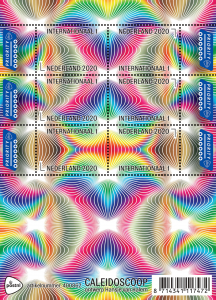 kaleidoscopic patterns. In the cheerful and playful stamp sheetlet full of optical illusions, graphic designer Hansje van Halem, winner of the Dutch Design Award for Communication in 2018, has applied all the colors from the color box. [A larger picture of the full sheet is shown at the end of this page.]
kaleidoscopic patterns. In the cheerful and playful stamp sheetlet full of optical illusions, graphic designer Hansje van Halem, winner of the Dutch Design Award for Communication in 2018, has applied all the colors from the color box. [A larger picture of the full sheet is shown at the end of this page.]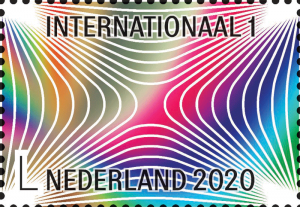 Van Halem started her design by drawing simple lines in a random pattern. “Without a goal, just try it out. For me, drawing equals searching, discovering. You have to look closely at what you are doing to understand what you have done. In the process I try to discover what I want to achieve. For example, I make a lot of endpapers for books and they are of course decorative. There too I look for harmony by creating optical illusions, just as happened with these stamps. ”
Van Halem started her design by drawing simple lines in a random pattern. “Without a goal, just try it out. For me, drawing equals searching, discovering. You have to look closely at what you are doing to understand what you have done. In the process I try to discover what I want to achieve. For example, I make a lot of endpapers for books and they are of course decorative. There too I look for harmony by creating optical illusions, just as happened with these stamps. ”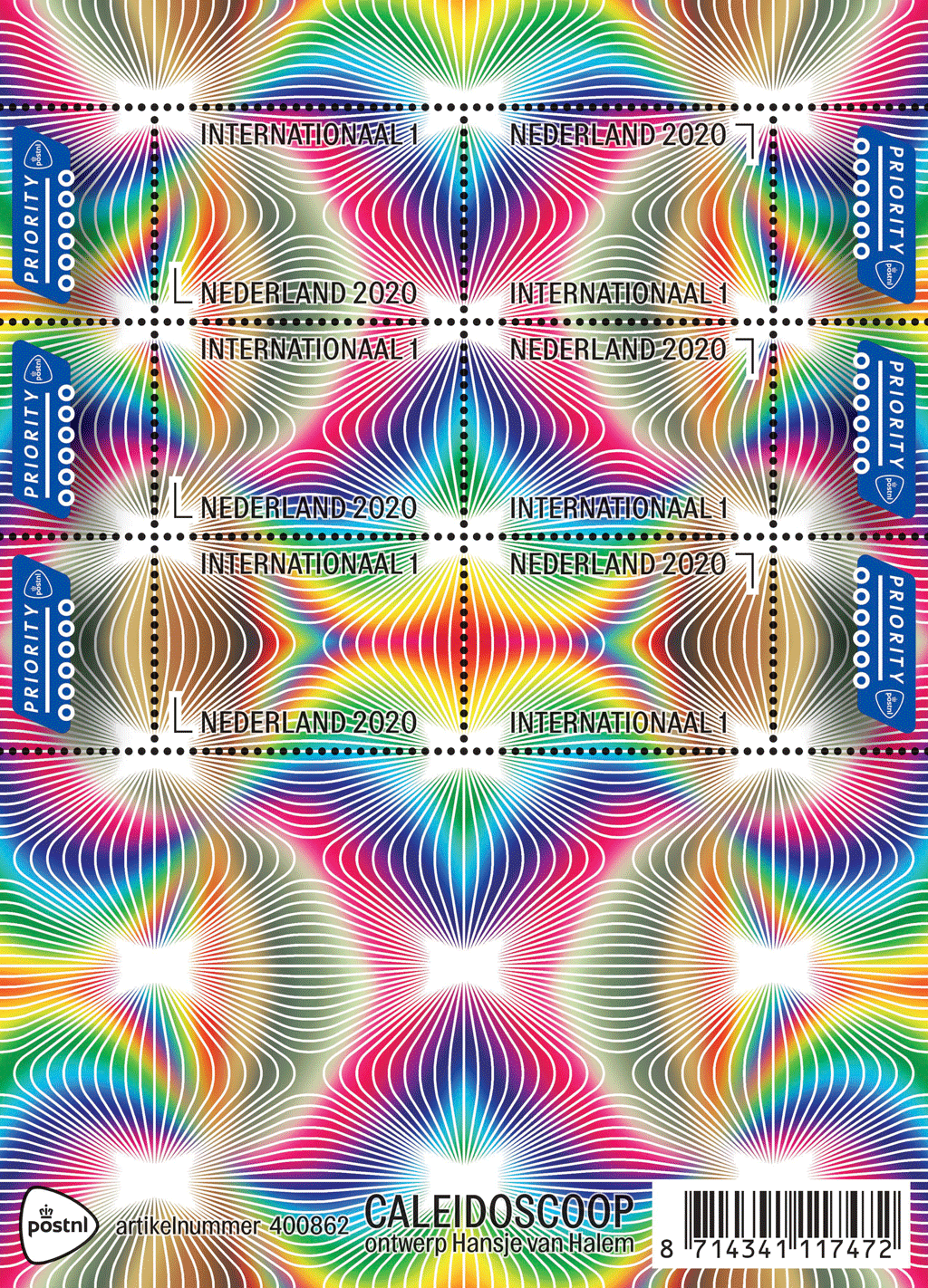
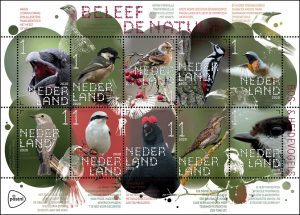 The Hague, September 14, 2020. On the latest stamp sheetlet from the “Experience nature” series, forest and heather birds play the leading role. The ten depicted birds on the stamps are the raven, coal tit, keep, great spotted woodpecker, red-collared redstart, greylag flycatcher, gray shrike, black grouse, wryneck and rump head. [Larger illustration of full sheet at end]
The Hague, September 14, 2020. On the latest stamp sheetlet from the “Experience nature” series, forest and heather birds play the leading role. The ten depicted birds on the stamps are the raven, coal tit, keep, great spotted woodpecker, red-collared redstart, greylag flycatcher, gray shrike, black grouse, wryneck and rump head. [Larger illustration of full sheet at end]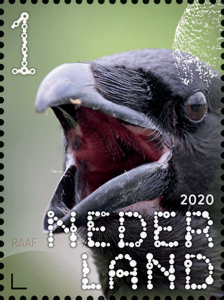 sheetlet “Experience nature” costs € 9.10. The price for the full series 2020 is € 36.40, including storage folder.
sheetlet “Experience nature” costs € 9.10. The price for the full series 2020 is € 36.40, including storage folder.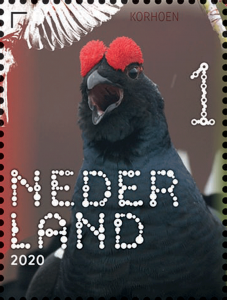 nature. Janse: “It has become a beautiful autumnal sheet with a mossy green in the background, which fits exactly with this season. In the center of the sheet, red accents draw the attention: the background by the gray shrike, the eyebrows of the black grouse, the berries at the keep and the “pants” of the great spotted woodpecker.”
nature. Janse: “It has become a beautiful autumnal sheet with a mossy green in the background, which fits exactly with this season. In the center of the sheet, red accents draw the attention: the background by the gray shrike, the eyebrows of the black grouse, the berries at the keep and the “pants” of the great spotted woodpecker.”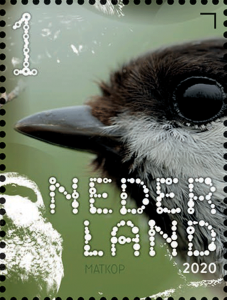 Heather birds in particular have a difficult time in our country due to the deterioration in the quality of heathland areas and the sharp decrease in the number of insects. Many bird species have therefore entered the danger zone. The black grouse, for example, is on the verge of disappearing. The wheatear can hardly be found on heaths anymore, but it can still be found in dune areas. The gray shrike only occurs as a winter guest in our country.
Heather birds in particular have a difficult time in our country due to the deterioration in the quality of heathland areas and the sharp decrease in the number of insects. Many bird species have therefore entered the danger zone. The black grouse, for example, is on the verge of disappearing. The wheatear can hardly be found on heaths anymore, but it can still be found in dune areas. The gray shrike only occurs as a winter guest in our country.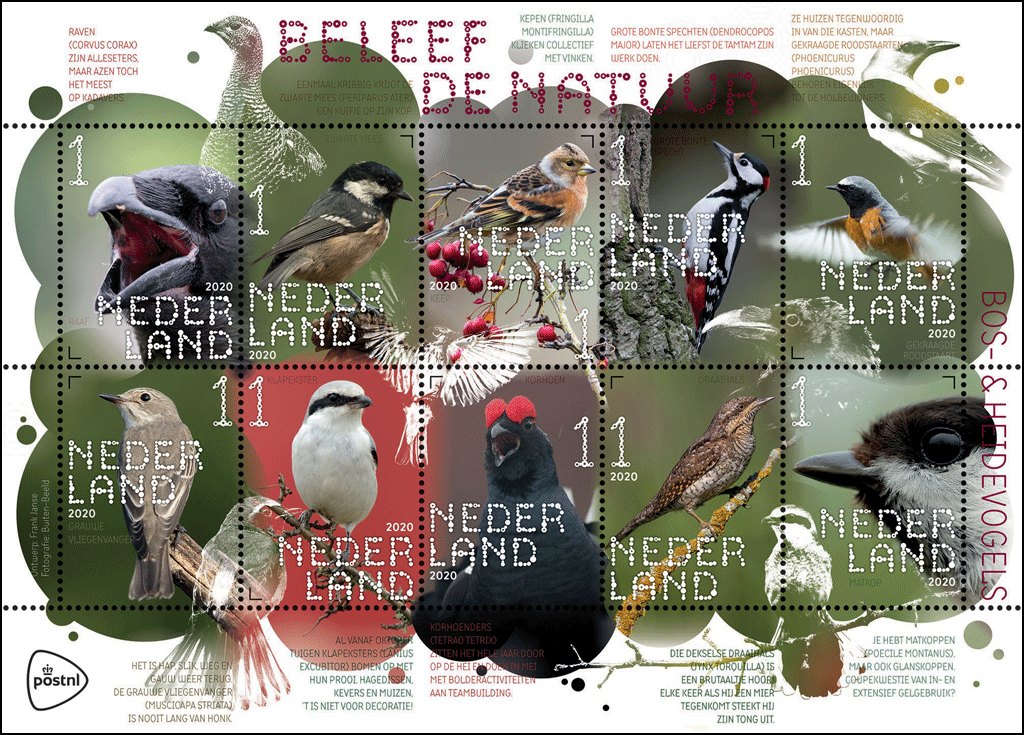
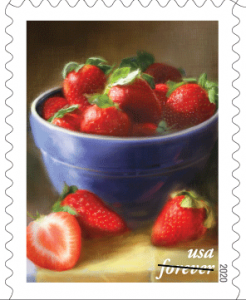 5484 (55¢) Fruits and Vegetables – Red and black plums
5484 (55¢) Fruits and Vegetables – Red and black plums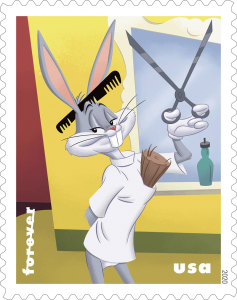 5495 (55¢) Bugs Bunny, 80th Anniv. – Basketball player
5495 (55¢) Bugs Bunny, 80th Anniv. – Basketball player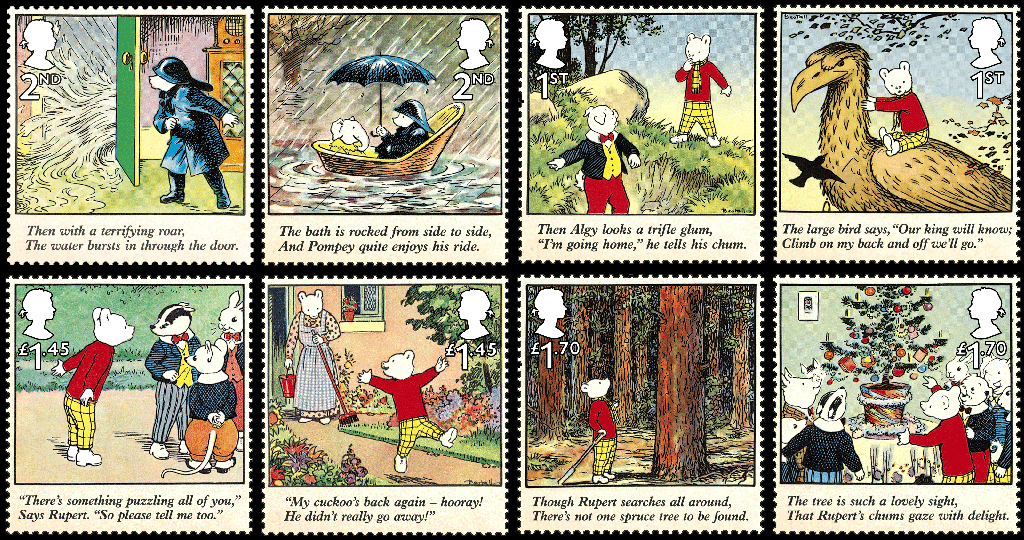
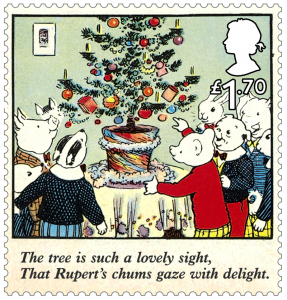 Mare’s Nest (1952), Rupert And The Lost Cuckoo (1963) and Rupert’s Christmas Tree (1947)
Mare’s Nest (1952), Rupert And The Lost Cuckoo (1963) and Rupert’s Christmas Tree (1947) Rupert Bear. The stamps feature the artwork of Alfred Bestall, who wrote and illustrated more than 270 Rupert stories after he took on the role in 1935.
Rupert Bear. The stamps feature the artwork of Alfred Bestall, who wrote and illustrated more than 270 Rupert stories after he took on the role in 1935.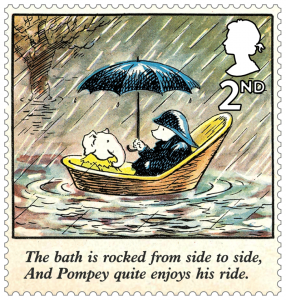 at the Express, and his wife, Mary, was the illustrator.
at the Express, and his wife, Mary, was the illustrator.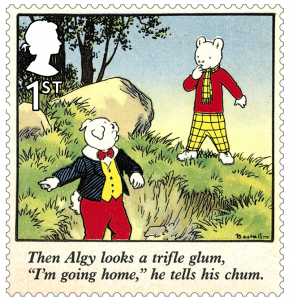 Her replacement was Alfred Bestall, an established artist with Punch and other magazines, who also illustrated children’s books. In total, he wrote and illustrated 224 Rupert stories for the newspaper and provided 47 other stories, mostly for the Rupert Annuals. In 1985 he was awarded the MBE for his work. He died the following year. It is his illustrations which are reproduced on the stamps which feature Rupert in adventures with some of friends including Algy Pup, Bill Badger and Pompey the baby elephant.
Her replacement was Alfred Bestall, an established artist with Punch and other magazines, who also illustrated children’s books. In total, he wrote and illustrated 224 Rupert stories for the newspaper and provided 47 other stories, mostly for the Rupert Annuals. In 1985 he was awarded the MBE for his work. He died the following year. It is his illustrations which are reproduced on the stamps which feature Rupert in adventures with some of friends including Algy Pup, Bill Badger and Pompey the baby elephant.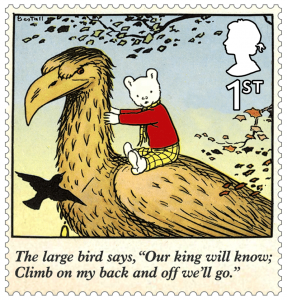 whereby every picture had a rhyming couplet underneath, plus a few lines of story text to accompany them. Bestall’s couplets often ended with the promise of a mystery, so that the next day’s paper was eagerly awaited by children, curious to see how the story would unfold. Bestall also introduced new characters to add variety, including Lily Duckling, Gregory Guineapig, the Old Professor, Bingo and the Imps of Spring and Autumn. Most Rupert stories commence with the bear leaving home and end with him returning after an adventure in time for tea to tell his mother of his experiences.
whereby every picture had a rhyming couplet underneath, plus a few lines of story text to accompany them. Bestall’s couplets often ended with the promise of a mystery, so that the next day’s paper was eagerly awaited by children, curious to see how the story would unfold. Bestall also introduced new characters to add variety, including Lily Duckling, Gregory Guineapig, the Old Professor, Bingo and the Imps of Spring and Autumn. Most Rupert stories commence with the bear leaving home and end with him returning after an adventure in time for tea to tell his mother of his experiences.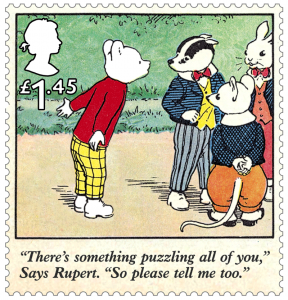 While books of reprinted Rupert stories appeared in the 1920s, it was decided that an annual publication would appear every Christmas. It was titled, Monster Rupert. The first volume was issued in 1931 and continued up to 1934, ceasing after Mary Tourtel retired.
While books of reprinted Rupert stories appeared in the 1920s, it was decided that an annual publication would appear every Christmas. It was titled, Monster Rupert. The first volume was issued in 1931 and continued up to 1934, ceasing after Mary Tourtel retired.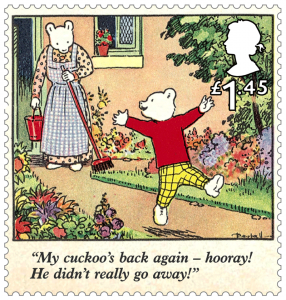 World War, the government sanctioned sufficient paper for the annuals to be printed, to help boost the morale of the public.
World War, the government sanctioned sufficient paper for the annuals to be printed, to help boost the morale of the public.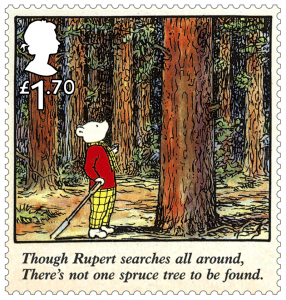 generations of children to a wonderful make-believe world of magic and adventure.”
generations of children to a wonderful make-believe world of magic and adventure.”

